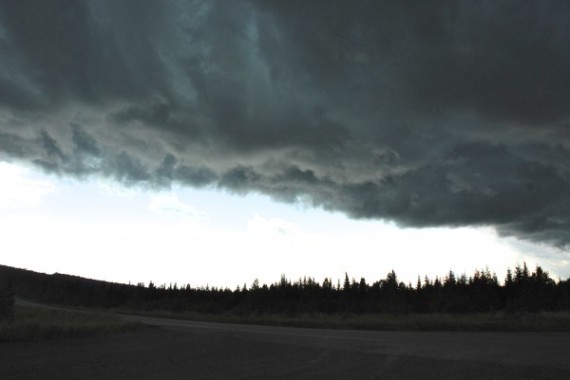Severe storm pounds Aroostook County

Dark clouds mark the line of a cold front pushing through northern Maine Saturday that prompted severe thunderstorm warnings over most of northern Maine.
Posted 23 July 2011, by Julia Bayly (Special to the BDN), Bangor Daily News, bangordaiynews.com
CARIBOU, Maine — A cold front tracking southeast through Central Aroostook County Friday evening brought heavy rains, lightning and damaging winds, causing power outages and some property damage.
As of Saturday morning the hardest hit areas appear to be Caribou and Ashland, where municipal crews were busy cleaning up fallen trees, downed power lines and snapped utility poles.
“It was a very severe thunderstorm,” Paul Fitzsimmons, meteorologist with the National Weather Service in Caribou, said Saturday morning. “Caribou was hit with strong straight-line winds; it was not a tornado.”
Fitzsimmons said weather investigators were expected in Ashland to determine exactly what kind of storm hit the area, as it was under a tornado watch Friday evening.
“We had a warm, unstable air mass and that just set the stage for the storms,” he said. “There was that real potential for them to be severe.”
Wind gusts of up to 75 miles per hour were recorded at the airport in Caribou, Fitzsimmons said, where close to an inch of rain fell in under an hour.
The storm passed through around 8 p.m.
The chance remains for another round of severe storms Saturday afternoon as a cold front from Quebec will pass over northern Maine.
“Once that front pushes through we are looking at cooler and drier air for Sunday,” Fitzsimmons said.

Chainsaws and other debris removal equipment could be heard all over central Aroostook County Saturday as residents cleaned up from damaging thunderstorms that passed over the area Friday night. Winds in excess of 75 miles per hour were recorded at the Caribou airport. Municipal and utility crews worked through the night and day to repair downed power lines, clear roads and restore electricity. On Saturday Caribou Garrick Milton helped his neighbor remove a fallen tree from his yard. "I've seen bad storms before," Milton said. "But I've never seen anything like last night.
http://bangordailynews.com/2011/07/23/news/aroostook/severe-storm-pounds-aroostook-county/








